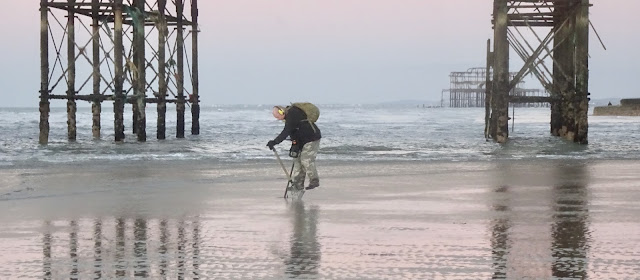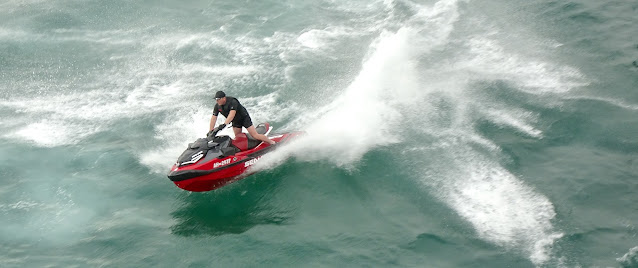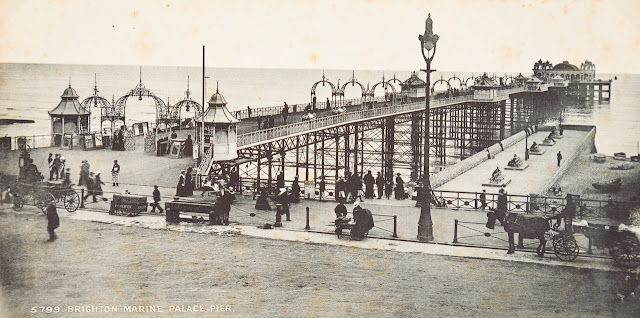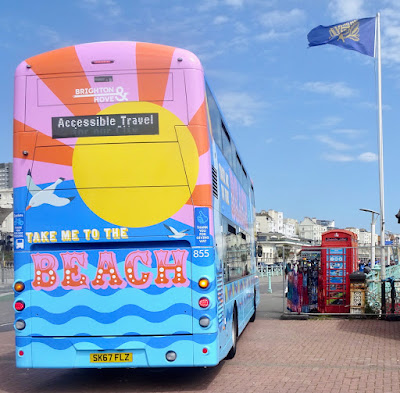‘Mark walks the shingle, slowly sweeping his metal detector from side to side listening for the bleep on his headphones? This isn’t his usual haunt. More often he’s down at the Volk’s Railway, where he takes his wife to get out of the flat. His wife’s not very well. She can’t go out on her own any more.’ This is the start of Story 32, about Brighton Beach, in William Shaw’s 41 Places 41 Stories (UnMadeUp, 2007). The small curio of a book was first published as a city-wide installation commission by the 2007 Brighton Festival.
Shaw, who now lives in Brighton, was once a music journalist but, around 2013, he turned - successfully to crime fiction (indeed, he has just published his latest novel - The Red Shore). 41 Places 41 Stories - which can be sampled online at Googlebooks - relates ‘true stories picked up on street corners, taxi ranks, pubs, car parks - even in public toilets’, with each one inhabiting its own geography: a specific place in the centre of a British seaside town. The publisher’s blurb explains; ‘If the essence of narrative is change, William Shaw distils it here in these tales of love, loss and self-discovery. Brighton is, after all, a place where people have always come to transform themselves.’
Story 32 is entitled The other day he found a 1966 American silver dollar on the beach. Makes you think, and it has a location subtitle - The beach between the piers. (The photograph above is my own, and has no direct link to Shaw’s book.) Here’s the piece:
‘Mark walks the shingle, slowly sweeping his metal detector from side to side listening for the bleep on his headphones?
This isn’t his usual haunt. More often he’s down at the Volk’s Railway, where he takes his wife to get out of the flat. His wife’s not very well. She can’t go out on her own any more.
Today, though, his daughter’s down to visit. She’s taken her mother out, so he’s come down here for a change.
He bends down and starts to dig with his trowel. Just under the surface, a shiny 50p piece.
When he was a boy living in First Avenue in Hove, this is where he used to scavenge empty coke bottles for the 3d return money. He would climb up under the West Pier and scour the beams for sixpenny bits that had fallen through the gaps in the boards.
Some make their living down here with metal detectors. At dawn, a half dozen of them will be inching across the stones picking up cash dropped from the pockets of drunken clubbers.
Not Mark. He’s not interested in the money any more. He spent his life going ninety miles an hour. Last couple of years he’s just stopped. For him this is more like archaeology - finding something, wondering how it got there. The other day he found a 1966 American silver dollar on the beach. Makes you think. What’s the story? It’s just a buzz, not knowing what you’re going to pull out. Like fishing.
Tonight he’s cooking sea bass, his favourite. He does all the cooking at home. He is the glue, the one that holds it together.
See those buildings on the seafront? Mark’s been on the roofs of most of them. He used to be a tiler. Working so high up all your life gives you a perspective. Up there, you lose the fear of dying, and with it, your sense of selfishness.
Another noise in his headphones. He reaches down and picks up a rust-crusted penny. That one may have been down there for years.’




















.jpeg)






.jpeg)







.jpeg)






